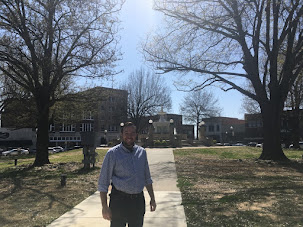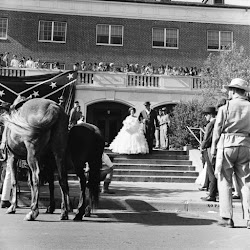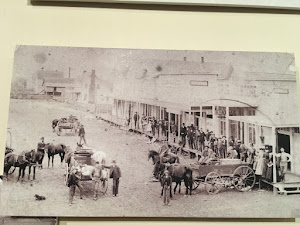The Texas Historical Commission recently released a new documentary titled Independence! A Lone Star Rises. The 30-minute feature discusses the challenging backstory behind the 1836 signing of the Texas Declaration of Independence at Washington-on-the-Brazos. The documentary, which is produced by the award-winning director Gary Foreman of Native Sun Productions, utilizes animation, archival photos, and real-life footage of costume-clad volunteers and reenactors in front of a delightful musical background, featuring the Grammy-nominated composer David Arkenstone. My former colleague from Austin College (and a close history-minded friend) Jameson Moore played the titular role of George Childress, the chief author of Texas's Declaration of Independence. Jameson took his part in the flick seriously, yet appeared to enjoy the filming. In this blog post, I will briefly chronicle the life of George Childress.
 |
| George Childress, a prolific Tennessean who would later become the author of Texas's Declaration of Independence, 1834. |
George Campbell Childress was born on January 8, 1804 in Nashville, Tennessee. This was eight years after Tennessee became a state. He was the son of local laborers John B. Campbell and Elizabeth Robertson. His sister Maltida married future U.S. Supreme Court Associate Justice John Catron. Childress attended Davidson Academy (later the University of Nashville) and was admitted to the Tennessee Bar in 1928. He was the chief editor for the Nashville Banner, and enjoyed writing opinion pieces on local politics for ten years. Childress married Margaret Vance on June 12, 1828, but she would die shortly after giving birth to a boy in March 1835. The young, ambitious writer visited Texas (then a Mexican colony) in December 1834, where his uncle, empresario Sterling C. Robertson, was establishing the Robertson's Colony in what is today Central Texas. Childress enjoyed his trip to Texas and vowed to return; he would spend the next several month mustering money and volunteers for the Texas Army after he heard of the Texian's victory at Gonzales in October 1835. On December 1, 1835, Childress permanently left Tennessee and arrived at the Red River twelve days later. Like many other Anglo settlers during this period, he illegally crossed the river into Mexico in violation of the Law of April 6, 1830. He reached the Robertson's Colony on January 9, 1836.
 |
| When Childress arrived in Texas in the mid-1830s, the Mexican colony was largely uninhabited and the settlers were growing restless against their ruthless government... |
Childress and his uncle were elected to represent the Milam Municipality at the Convention of 1836, which was held in a small, rustic and sparsely-populated town named the Washington-on-the-Brazos. Representatives from the colony's communities and municipalities (which included farmers, doctors, and lawyers) gathered on March 1, 1836, in one of the unfinished log cabins to change the course of history and discuss Texas's bright future (which would include declaring independence, creating an ad-interim government, and nominating Sam Houston as commander in chief of the military forces of the Republic). A majority of the representatives were young, under the age of 40. Similar to the scene their New England forefathers had faced against the British at the end of the eighteenth century, there was much debate among the Texians who had gathered at the convention. Should they reconcile with Mexico and face punishment or should they declare independence and fight a losing war (the delegates heard about the tough ordeal at the Alamo a few days after the convention started)? They took a risk when the future of their young Republic appeared gloomy. Their odds were overwhelmingly against them, especially after the Battle of the Alamo (March 6) and the Goliad Massacre (March 27).
Assuming control of the rowdy crowd, Childress (in his signature booming voice) called the convention to order, and armed with a heavy stack of books and papers, proclaimed he would establish a committee that would draft Texas's Declaration of Independence. The committee included Edward Conrad (a youthful lawyer), James Fannin (an officer in the Texas Army), Bailey Hardeman (later Texas's first secretary of the treasury), and Collin McKinney (a land surveyor who was the oldest person to sign the declaration). The group surprisingly finished drafting the groundbreaking document in one day, leading many to believe that Childress had arrived at the start of the convention with a copy in hand. The declaration mirrored the words of Thomas Jefferson's American Declaration of Independence of 1776. The first document had many writing errors, which were quickly fixed. Debate ensured in the near-freezing temperatures (since the log cabin did not have window panels or a door). The document was approved on March 2 and the signing took place a day later on March 3, 1836. Texas, the Lone Star Republic, had officially declared its breakup with Mexico.
 |
| The Texas Declaration of Independence, which was written in one night, mirrors the 1776 American document. |
On March 19, 1836, the first president of the new Republic, David G. Burnet, sent Childress and Robert Hamilton (presumably the wealthiest man to sign the Texas Declaration of Independence) to D.C. to seek recognition of the independence of Texas and establish commercial relationships with the United States (note, this was prior to Mexico's defeat at the Battle of San Jacinto and at the same time as the famous 'Runaway Scrape'). Their mission was terminated in May and the pair were replaced by James Collinsworth and Peter W. Grayson. Childress, proud of his work on Texas's principal document during its early days, returned to the private sector and opened three law firms in Houston and Galveston- each were unsuccessful. He married his second wife, a younger lassie named Rebecca Stuart Read Jennings in December 1836, and had two daughters. Since he struggled to provide for his family, Childress suffered from severe depression and committed suicide by slashing his abdomen with a bowie knife at his house in Galveston on October 6, 1841. He was 37 years old. Despite a tragic end, George Childress is a Texas hero, exhibiting unwavering patriotism and quality leadership when a struggling Republic was in a time of crisis. His expressive words of liberty, freedom and opportunity on Texas's declaration demonstrates the bravery, self-sacrifice and grit Texians faced in enormous odds.
 |
| I have not been to Washington-on-the-Brazos yet, but it is on my future travel list. The statue of Childress was erected in 1936, 100 years after the Texas Revolution (Wikipedia image). |
Childress's sacrifice to the Republic of Texas was later recognized. Childress County in the Panhandle is named in honor of the Texian author. A statue of Childress was also erected in Washington-at-the-Brazos in 1936, the year of the Texas Centennial.
In sum, the documentary was fantastic and I highly recommend showing it in your history classes if you are a social studies teacher: https://www.youtube.com/watch?v=9eq3Y8fnmUE














































